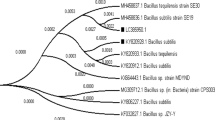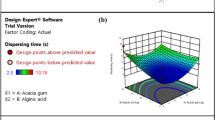Abstract
Exploitation of microbial metabolites as biocontrol agents is considered an alternative to chemical pesticides in organic farming, due to their extensive potentiality in enhancing crop protection and food safety. The present work elucidates antifungal and insecticidal activities, exerted by the biosurfactant produced by the bacterial strain Bacillus subtilis V26 in order to provide protection against gray mold caused by Botrytis cinerea, in grapes and the tomato leaf miner Tuta absoluta. In vitro antifungal assay showed a minimal inhibitory concentration of about 2 mg mL−1, leading to the swelling and the deformation of fungal hyphae. In vivo assays with the grapes, the biosurfactant V26 exhibited a significant protection against gray mold severity especially as a protective treatment at concentration of 2 mg mL−1. The biosurfactant V26 also exhibited remarkable insecticidal activity against Tuta absoluta larvae (LC50 = 278.78 ng cm−2), causing histological damages in the larval midgut. This study demonstrated that the biosurfactant V26 has a potential as biocontrol agent against fungal disease and pest, which could be a promising biocontrol molecule for achieving organic agriculture.




Similar content being viewed by others
References
Ben Khedher S, Boukedi H, Kilani-Feki O, Chaib I, Laarif A, Abdelkefi-Mesrati L, Tounsi S (2015) Bacillus amyloliquefaciens AG1 biosurfactant: histopathological effects and diversity of its putative receptors on Tuta absoluta midgut. J Invertbr Pathol 132:42–47
Biondi A, Zappalà L, Stark JD, Desneux N (2013) Do biopesticides affect the demographic traits of a parasitoid wasp and its biocontrol services through sublethal effects? PLoS One 8:e76548
Boukedi H, Sellami S, Ktari S, Belguith-Ben-Hassan N, Sellami-Boudawara T, Tounsi S, Abdelkefi-Mesrati L (2016) Isolation and characterization of a new Bacillus thuringiensis strain with a promising toxicity against Lepidopteran pests. Microbiol Res 186–187:9–15
Caparros Megido R, Haubruge E, Verheggen FJ (2013) Pheromone-based management strategies to control the tomato leafminer, Tuta absoluta (Lepidoptera: Gelechiidae). A review. Biotechnol Agron Soc Environ 17:475–482
Chowdhury SP, Uhl J, Grosch R, Alqueres S, Pittroff S, Dietel K et al (2015) Cyclic lipopeptides of Bacillus amyloliquefaciens subsp. plantarum colonizing the lettuce rhizosphere enhance plant defence responses towards the bottom rot pathogen Rhizoctonia solani.Mol. Plant Microb Interact 28:17–18
Dammak M, Ben Khedher S, Boukedi H, Chaib I, Laarif A, Tounsi S (2016) Involvement of the processing step in the susceptibility/tolerance of two lepidopteran larvae to Bacillus thuringiensis Cry1Aa toxin. Pestic Biochem Physiol 127:46–50
de Almeida Melo AL, Soccol VT, Soccol CR (2014) Bacillus thuringiensis: mechanism of action, resistance, and new applications: a review. Crit Rev Biotechnol 36:317–326
Desneux N, Waynberg E, Wyckhuys KAG, Burgio G, Arpaia S, Narvaez-Vasquez CA, Gonzalez Cabrera J, Catalan-Ruescas D, Tabone E, Frandon J, Pizzol J, Poncet C, Cabello T, Urbaneja A (2010) Biological invasion of European tomato crops by Tuta absoluta: ecology, history of invasion and prospects for biological control. J Pest Sci 83:197–215
Dewi RTK, Mubarik NR, Suhartono MT (2016) Medium optimization of β-glucanase production by Bacillus subtilis SAHA 32.6 used as biological control of oil palm pathogen. Emir J Food Agric 28:116–125
Droby S, Lichter A (2004) Post-harvest Botrytis infection: etiology, development and management. In: Elad Y, Williamson B, Tudzynski P, Delen N (eds) Botrytis: Biology. Pathology and Control. Kluwer Academic Publishers, London, pp 349–367
Ghribi D, Abdelkefi-Mesrati L, Boukedi H, Elleuch M, Ellouze-Chaabouni S, Tounsi S (2012) The impact of the Bacillus subtilis SPB1 biosurfactant on the midgut histology of Spodoptera littoralis (Lepidoptera: Noctuidae) and determination of its putative receptor. J Invertebr Pathol 109:183–186
Hasna MK, Mårtensson A, Persson P, Rämert B (2007) Use of composts to manage corky root disease in organic tomato production. Ann Appl Biol 151:381–390
Kilani-Feki O, Culioli G, Ortalo-Magne A, Zouari N, Blache Y, Jaoua S (2011) Environmental Burkholderia cepacia strain Cs5 acting by two analogous alkylquinolones and a didecyl-phthalate against a broad spectrum of phytopathogens fungi. Curr Microbiol 62:1490–1495
Kilani-Feki O, Ben Khedher S, Dammak M, Kamoun A, Jabnoun-Khiareddine H, Daami-Remadi M, Tounsi S (2016) Improvement of antifungal metabolites production by Bacillus subtilis V26 for biocontrol of tomato postharvest disease. Biol Control 95:72–83
Koglin A, Doetsch V, Bernhard F (2010) Biosurfactants—molecular engineering aspects for the production of new and modified biosurfactants. Springer, New York, pp 158–169
Latorre BA, Spadaro I, Rioja ME (2002) Occurrence of resistant strains of Botrytis cinerea to anilinopyrimidine fungicides in table grapes in Chile. Crop Prot 21:957–961
Leroux P (2004) Chemical control of Botrytis and its resistance to chemical fungicides. In: Elad Y, Williamson B, Tudzynski P, Delen N (eds) Botrytis: biology, Pathology and Control. Kluwer Academic, Dordrecht, pp 195–222
Letourneau D, van Bruggen AHC (2006) Crop protection. In: Kristiansen P, Taji A, Reganold J (eds) Organic agriculture: a global perspective. CSIRO, Melbourne, pp 93–121
Liu XY, Yang SZ, Mu BZ (2008) Isolation and characterization of a C12-lipopeptide produced by Bacillus subtilis HSO121. J Pept Sci 14:864–875
Marchant R, Banat IM (2012) Microbial biosurfactants: challenges and opportunities for future exploitation. Trends Biotechnol 30:558–565
Medeiros MA, Vilela NJ, França FH (2006) Technical and economic efficiency of biological control of the South American tomato pinworm in protected environment. Hortic Bras 24:180–184
Mnif I, Hammami I, Triki MA, Cheffi Azabou M, Ellouze-Chaabouni S, Ghribi D (2015) Antifungal efficiency of a lipopeptide biosurfactant derived from Bacillus subtilis SPB1 versus the phytopathogenic fungus, Fusarium solani. Environ Sci Pollut Res 22:18137–11847
Ongena M, Jacques P (2008) Bacillus lipopeptides: versatile weapons for plant disease biocontrol. Trends Microbiol 16(3):115–125
Parafati L, Vitale A, Restuccia C, Cirvilleri G (2015) Biocontrol ability and action mechanism of food-isolated yeast strains against Botrytis cinerea causing post-harvest bunch rot of table grape. Food Microbiol 47:85–92
Queiroz OS, Ramos RS, Gontijo LM, Picanço MC (2015) Functional response of three species of predatory pirate bugs attacking eggs of Tuta absoluta (Lepidoptera: Gelechiidae). Environ Entomol 44:246–251
Roditakis E, Vasakis E, Grispou M, Stavrakaki M, Nauen R, Gravouil M, Bassi A (2015) First report of Tuta absoluta resistance to diamide insecticides. J Pest Sci 88(1):9–16
Romano A, Vitullo D, Senatore M, Lima G, Lanzotti V (2013) Antifungal cyclic lipopeptides from Bacillus amyloliquefaciens strain BO5A. J Nat Prod 76:2019–2025
Ruiz LM, Segura C, Trujillo J, Orduz S (2004) In vivo binding of the Cry11Bb toxin of Bacillus thuringiensis subsp. medellin to the midgut of mosquito larvae (Diptera: Culicidae). Mem Inst Oswaldo Cruz 99:73–79
Sachdev DP, Cameotra SS (2013) Biosurfactants in agriculture. Appl Microbiol Biotechnol 97:1005–1016
Saito S, Michailides TJ, Xiao CL (2016) Fungicide resistance profiling in Botrytis cinerea populations from blueberry in California and Washington and their impact on control of gray mold. Plant Dis 100:2087–2093
Shafi J, Tian H, Ji M (2017) Bacillus species as versatile weapons for plant pathogens: a review. Biotechnol Biotechnol Equip 31(3):446–459
Tareq FS, Lee MA, Lee HS, Lee YJ, Lee JS, Hasan CM, Islam MT, Shin HJ (2014) Non-cytotoxic antifungal agents: isolation and structures of gageopeptides A-D from a Bacillus strain 109GGC020. J Agric Food Chem 62:5565–5572
Toral L, Rodríguez M, Béjar V, Sampedro I (2018) Antifungal activity of lipopeptides from Bacillus XT1 CECT 8661 against Botrytis cinerea. Front Microbiol 9:1315
van Bruggen AHC (1995) Plant disease severity in high-input compared to reduced-input and organic farming systems. Plant Dis 79:976–984
Vecino X, Barbosa-Pereira L, Devesa-Rey R, Cruz JM, Moldes AB (2015) Optimization of extraction conditions and fatty acid characterization of Lactobacillus pentosus cell-bound biosurfactant/bioemulsifier. J Sci Food Agric 95:313–320
Yogev A, Raviv M, Kritzman G, Hadar Y, Cohen R, Kirshner B, Katan J (2009) Suppression of bacterial canker of tomato by composts. Crop Prot 28:97–103
Zhang QX, Zhang Y, Shan HH, Tong YH, Chen XJ, Liu FQ (2017) Isolation and identification of antifungal peptides from Bacillus amyloliquefaciens W10. Environ Sci Pollut Res Int 24:25000–25009
Funding
This work is financially supported by the “Tunisian Ministry of Higher Education and Scientific Research.”
Author information
Authors and Affiliations
Corresponding author
Ethics declarations
Conflict of interest
The authors declare that they have no conflict of interests.
Additional information
Publisher’s note
Springer Nature remains neutral with regard to jurisdictional claims in published maps and institutional affiliations.
Rights and permissions
About this article
Cite this article
Ben Khedher, S., Boukedi, H., Laarif, A. et al. Biosurfactant produced by Bacillus subtilis V26: a potential biological control approach for sustainable agriculture development. Org. Agr. 10 (Suppl 1), 117–124 (2020). https://doi.org/10.1007/s13165-020-00316-0
Received:
Accepted:
Published:
Issue Date:
DOI: https://doi.org/10.1007/s13165-020-00316-0




